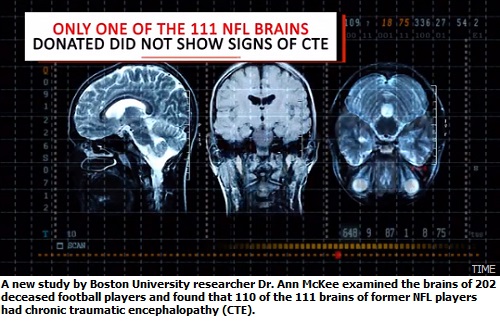
|
|

|
|
| April 26, 2024 |
|
Brain disease found in 110 out of 111 former NFL players 
How many more dead athletes do we need before we stop quibbling about the toll of head trauma? How many more autopsies that find brains riddled with disease? How many more heart-wrenching stories of mood changes, depression and memory loss?
100? 200? Because we’re already there. A new study published Tuesday in the Journal of American Medical Association found chronic traumatic encephalopathy (CTE) in the brains of 110 out of 111 former NFL players. Let that sink in for a minute. With 53 players on regular-season rosters, that’s the equivalent of taking two teams plus a couple of practice squad guys and finding CTE in every player but one. Makes you look at your favorite team a little differently, doesn’t it? It’s not just NFL players who are vulnerable, either. The brains of 202 men who played football at the youth level, high school, college, semiprofessional, Canadian Football League and NFL were studied by researchers from Boston University and the VA Boston Healthcare System, and 177 were found to have CTE. That’s 87%. Of that 177, 93% had shown symptoms of cognitive trouble before their deaths and 91% exhibited changes in behavior or mood. Now, this doesn’t mean every NFL player is going to get CTE or that playing in high school is akin to signing a death certificate. All of the brains were donated, mostly by family members who suspected or feared their loved ones had CTE. Nor does the study show why blows to the head cause CTE, or how many blows are too many. But the numbers and details are staggering enough that they ought to finally bring an end to the double talk and denials by the NFL, NHL, FIFA and other professional sports organizations about the role their sports play in the deaths of those who played it. “My major frustration is that we spend so much time not talking about how to solve this disease, how to find treatments, how to find ways to detect this disease. And we spend loads of money and time debating whether this is a disease,” said Ann McKee, a neuropathologist at Boston University and author of the study. “To me, that’s obvious,” McKee added in an interview with USA TODAY Sports. “Let’s move. Let’s bring some hope to people that have (CTE) and not contribute to future generations by leaving this problem unsolved. That’s what’s frustrating to me.” When Jeff Miller, the NFL’s senior vice president of health and safety, grudgingly acknowledged a link between football and CTE during a Congressional hearing in March 2016, it appeared to be a reversal of years of vehement denials by the league. But within a few hours, the NFL had fallen back on its “We need more science” stance. NHL Commissioner Gary Bettman is even more obstinate, saying there is still no definitive proof of a link between repetitive head trauma and neurodegenerative diseases like CTE. While that’s technically true, it's also like choking on smoke that can be both smelled and seen and continuing to insist it doesn’t necessarily mean there’s a fire. “This is a critical mass of evidence,” McKee said. “It’s no longer debatable it’s a problem.” The leagues have been reluctant to admit a link between head trauma and CTE because it leaves them liable. The NFL is in the process of paying out a $1 billion settlement to former players who said the league failed to warn them of the dangers of head trauma. The NHL is currently facing a similar lawsuit from its former players. It also could make it hard to attract youngsters to the sport. Parents tend to be a little skittish of signing their child up for something that could have debilitating consequences in 30, 40 or 50 years. But ignoring the obvious won't make it go away. More answers are needed, as is a way to diagnose CTE while someone is still alive; an autopsy is currently the only way to say with certainty that a person had the disease. The brains at the center of Tuesday’s research will help find those answers, and support, and money, from the likes of the NFL and NHL would help speed them along. “I’m very optimistic that this disease can have an effective cure,” McKee said. “But we have to apply our resources effectively to do that.” Almost 200 men died without answers. How many more is it going to take? (Source: USA Today) Story Date: July 26, 2017
|